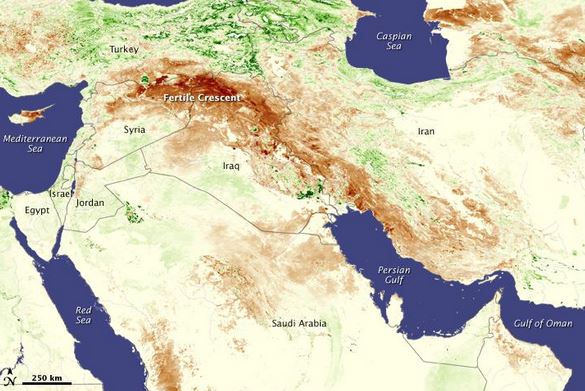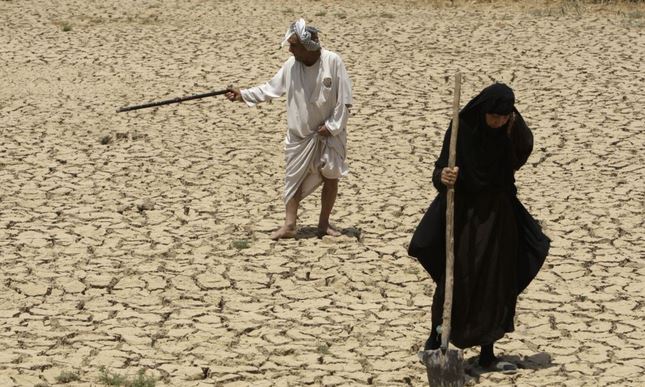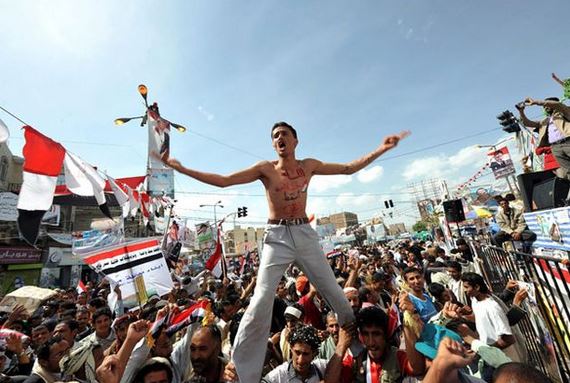Climate change brought about a record drought in Syria from 2006 to 2010, which was probably caused by human-induced climate change. The drought may have fueled the 2011 Syrian uprising and the war that followed, a new study suggests.
The 2006-2010 drought, which destroyed agriculture in the breadbasket northern region, was the worst ever recorded in Syria.
Dispossessed farmers were driven to cities, where government mismanagement, poverty and a number of other factors fueled the unrest that erupted in spring 2011.

An unprecedented drought (brown areas) lasting from 2006 to 2010 spread over Iraq, Syria and much of Turkey. (Credit: NASA)
The uprising evolved into a complex multinational war that has so far killed at least 200,000 men, women and children, and displaced millions.
The study, carried out by researchers from the University of California and Columbia University, has been published in the academic journal Proceedings of the National Academy of Sciences (citation below).
Co-author, Professor Richard Seager, a climate scientist at Columbia University’s Lamont-Doherty Earth Observatory, said:
“We’re not saying the drought caused the war. We’re saying that added to all the other stressors, it helped kick things over the threshold into open conflict. And a drought of that severity was made much more likely by the ongoing human-driven drying of that region.”
According to a growing body of evidence, it appears that extreme weather conditions, including droughts and high temperatures, raise the risk of violence, from isolated attacks to full-scale wars.
Global warming likely to cause more conflicts
Some studies are forecasting that human-induced global warming will contribute towards future conflicts. In fact, many researchers say this is already happening.
Prof. Seager and colleagues point out that “Recent journalistic accounts and other reports have linked warfare in Syria, Iraq and elsewhere in part to environmental issues, especially lack of water.”
The recent half-decade-long drought affected the Fertile Crescent, which spans much of Syria, Iraq and parts of Turkey, where crop and livestock farming is believed to have started about 12,000 years ago.

During the record drought, Syrian farmers abandoned the countryside and moved to the cities.
That part of the world has experienced natural weather swings. However, according to the study’s findings as well as previous research, since 1900 the Fertile Crescent has undergone warming of between 1°C and 1.2°C (about 2°F), plus a 10% decline in wet-season rainfall.
The researchers demonstrated that this climate trend matches closely with models of human-induced global warming, and thus could not be attributed to natural weather swings.
Two effects of global warming
Prof. Seager and colleagues say global warming has had two effects:
1. It seems to have indirectly weakened wind patterns that bring rainfall from the Mediterranean, thus reducing precipitation during the wet season of November to April.
2. Higher temperatures mean faster evaporation of moisture from soils during the usually hot summers.
There were substantial droughts in the region in the 1900s, 1980s and 1950s. However, they were nothing compared to the 2006-2010 drought – the worst ever to hit the Fertile Crescent. The research team concluded that an episode of this length and severity would have been unlikely had long-term changes not been present.
According to other studies, including one by the U.S. National Oceanic and Atmospheric Administration, the whole Mediterranean is gradually getting drier, which is partly due to human-induced warming.

The unrest began in the early spring of 2011 in the suburbs drought-stricken farmers had moved into.
The Intergovernmental Panel on Climate Change says the Mideast, which is already violent, will become drier in the decades to come as man-made warming proceeds.
Syria’s population explosion – from 4 million in the 1950s to 22 million today – was also a contributory factor.
Co-author Shahrzad Mohtadi, a graduate student at Columbia’s School of International and Public Affairs, who studied the social and economic components of the research, added that the ruling al-Assad family also exacerbated the problem by encouraging water-intensive exports crops like cotton.
The illegal drilling of irrigation wells significantly depleted groundwater that may have provided reserves during the parched years.
Syrian agriculture was devastated
Syria’s devastating drought reduced agricultural production – which typically represented one quarter of the country’s GDP (gross domestic product) – by one third. In the hard-hit northeast region, livestock herds virtually vanished, cereal prices went through the roof, and diseases linked to malnutrition among children increased dramatically.
The country’s cities, which were already struggling to cope with influxes of refugees from the war in Iraq, received up to 1.5 Syrians from the countryside.
The Assad regime did little to help people in these sprouting suburbs with services or employment – the very areas where the uprising began, Mohtadi explained.
The authors wrote:
“Rapid demographic change encourages instability. Whether it was a primary or substantial factor is impossible to know, but drought can lead to devastating consequences when coupled with preexisting acute vulnerability.”
Professor of public policy at the University of California, Berkeley Solomon Hsiang, who studies climate and conflict, said the study is “the first scientific paper to make the case that human-caused climate change is already altering the risk of large-scale social unrest and violence.”
Prof. Hsiang points out that it is not the first time the region has faced turmoil from droughts. About 4,200 years ago, the Akkadian Empire probably collapsed because of a multi-year drought.
Marshal Burke, from Stanford University, an environmental specialist, said:
“There were many things going on in the region and world at that time, such as high global food prices and the beginning of the Arab Spring, that could have also increased the likelihood of civil conflict.” But, he said, the study is “consistent with a large body of statistical evidence linking changes in climate to conflict.”
Citation: “Climate change in the Fertile Crescent and implications of the recent Syrian drought,” Colin P. Kelley, Shahrzad Mohtadi, Mark A. Cane, Richard Seager, and Yochanan Kushnir. Proceedings of the National Academy of Sciences. Published online before print March 2, 2015. DOI: 10.1073/pnas.1421533112.

